ZEN MESTEREK ZEN MASTERS
« Zen főoldal
« vissza a Terebess Online nyitólapjára
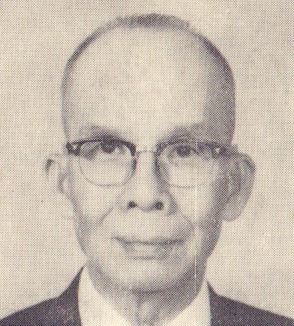
Lu K'uan Yü [Charles Luk]
陸寬昱 Lu Kuanyu (1898-1978)
Translations by Lu K'uan Yü (Charles Luk)
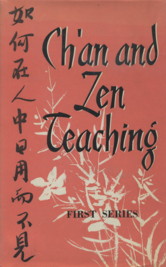
Ch'an and Zen Teaching – First Series
Rider & Co., London, 1960.
(PDF version of the complete book)
CONTENTS
Editor's Foreword
PART I
Master Hsu Yun's Discourses and Dharma Words pp. 17-117.1 Prerequisites of the Ch'an Training
2 The Ch'an Training
3 Daily Lectures at Two Ch'an Weeks
4 The Master's Arrival at Ts'ao ChiPART II
Stories of Six Ch'an Masters from The Imperial Selection of Ch'an Sayings (Yu Hsuan Yu Lu)
Foreword 1211 Master Teh Ch'eng The Boat Monk at Hua Ting pp. 123-128.
2 Master Chi Hsien of Hsiang Yen pp. 129-131.
3 Master Chu Ti of Chin Hua pp. 134-135.
4 Master Hui Ts'ang of Shih Kung pp. 136-138.
5 Master Wu Chu, alias Wen Hsi of Hang Chou pp. 139-142.
6 Master Fu Ta Shih (Bodhisattva Fu, alias Shan Hui) pp. 143-145.PART III
The Diamond Cutter of Doubts
A Commentary on the Diamond Sutra by Ch'an Master Han ShanForeword
Preface
Part One
Part Two
PART IV
A Straight Talk on the Heart Sutra by Ch'an Master Han Shan pp. 209-223.Foreword
CommentaryChinese Appendix of Persons, Places and Terms
Glossary of Chinese and Sanskrit Names, Terms and Places, with dates where known
Index
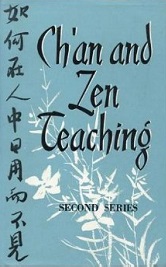
Ch'an and Zen Teaching – Second Series
Rider & Co., London, 1961.
(PDF version of the complete book)
CONTENTS
Preface
PART I
The Forty Transmission Gathas pp. 18-19, 27-53.1 The Seven Buddhas of Antiquity
2 The Twenty-seven Indian Patriarchs
3 The Six Chinese PatriarchsPART II
The Stories of the Founders of the Five Ch'an Sects1 The Kuei Yang Sect (Ikyo Zen), pp. 57-68.
Master Ling Yu of Kuei Shan2 The Kuei Yang Sect (Ikyo Zen), pp. 69-83.
Master Hui Chi of Yang Shan3 The Lin Chi Sect (Rinzai Zen)
Master I Hsuan of Lin Chi4 The Ts'ao Tung Sect (Soto Zen)
Master Liang Chiai of Tung Shan > Seal of the Precious Mirror Samadhi5 The Ts'ao Tung Sect (Soto Zen)
Master Pen Chi of Ts'ao Shan6 The Yun Men Sect (Ummon Zen)
Master Wen Yen of Yun Men7 The Fa Yen Sect (Hogen Zen), pp. 215-228.
Master Wen I of Ch'ing Liang Monastery, generally known by his posthumous title of Fa YenChinese Appendix of Persons, places and Terms
Glossary of Chinese and Sanskrit Names, Terms and places
Index
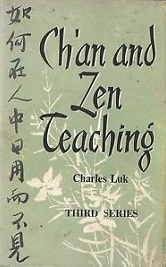
Ch'an and Zen Teaching – Third Series
Rider & Co., London, 1962.
(PDF version of the complete book)
CONTENTS
PART I
The Altar Sutra of the Sixth Patriarch, pp. 9-102. Part 1; Part 2;
Foreword
Preface by Ch'an Master Fa Hai1 How he Acquired the Dharma
2 Prajna
3 Queries
4 Dhyana and Prajna
5 Sitting in Meditation
6 Repentance and Reform
7 Potentiality and Condition
8 Instantaneous and Gradual Enlightenment
9 Imperial Patronage
10 His Last InstructionPART II
Yung Chia's Song of EnlightenmentForeword
Yung Chia 's Song of Enlightenment [without the commentary] pp. 103-145.PART III
The Sutra of Complete Enlightenment
Foreword
Preface by Ch'an Master Han Shan
The Sutra of Complete Enlightenment1 Manjusri Bodhisattva
2 Samantabhadra Bodhisattva
3 The Bodhisattva with Universal Eyes
4 Vajragarbha Bodhisattva
5 Maitreya Bodhisattva
6 The Bodhisattva of Pure and Clean Wisdom
7 The Respect Inspiring Sovereign Bodhisattva
8 The Sound Distinguishing Bodhisattva
9 The Bodhisattva of Clean Karma
10 The Bodhisattva of Universal Enlightenment
11 The Bodhisattva of Complete Enlightenment
12 The Sage Leader BodhisattvaChinese Appendix of Persons, places and Terms
Glossary of Chinese and Sanskrit Names, Terms and places
Index
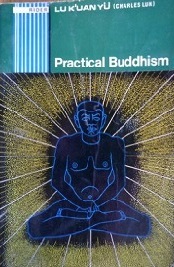
Practical Buddhism
Rider & Co., London, 1971.
(PDF version of the complete book)
CONTENTS
Preface
PART I The Buddha-Dharma (Theory and Practice)
PART II The Story of the Third ch'an Patriarch of China and his gatha 'Have Faith in Your Mind' pp. 33-38.
PART III The Ch'an Shout, by Ch'an Master Chi Ch'eng [淨因繼成 Jingyin Jicheng] pp. 39-42.
From The Imperial Selection of Ch'an Sayings [御選語錄 Yuxuan yulu]PART IV Master Han Shan's Experiment with the Mind, pp. 43-55.
PART V The Autobiography of Ch'an Master Han Shan (1546-1623)
Translated from Master Han Shan's Journey to Dreamland, pp. 57-162.Glossary
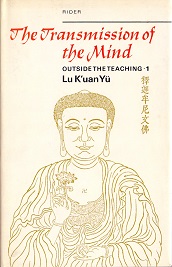
The Transmission of the Mind Outside the Teaching
Rider & Co., London, 1974.
(PDF version of the complete book)
Translated from 古尊宿語錄 Guzunsu yulu [Recorded Sayings of the Ancient Worthies], compiled in 1267
CONTENTS
Preface / 9
Genealogical Chart of The Dharma Descendants of the Sixth Patriarch Hui Neng / 31
The First Generation After The Patriarch Hui Neng: Ch'an Master Huai Jang of Nan Yo Mountain / pp. 32-37.
The Second Generation After The Patriarch Hui Neng: Ch'an Master Ma Tsu / 38
The Third Generation After The Patriarch Hui Neng: Ch'an Master Pai Chang / pp. 50-62.
The Fourth Generation After The Patriarch Hui Neng: Ch'an Master Huang Po, Also Called Hsi Yun and Tuan Chi / 121
The Fifth Generation After The Patriarch Hui Neng: Ch'an Master I Hsuan, Also Called Lin Chi / p. 184.
"The story and teaching of Ch'an master Lin Chi having
been presented in our book, Ch'an and Zen Teaching, Second Series
(PDF version of the complete book), we do not propose to repeat them
in the present volume and request our readers to refer to the said series."The Sixth Generation After The Patriarch Hui Neng: Ch'an Master Hsing Hua / pp. 185-191.
PDF: Empty Cloud: The Autobiography of a Chinese Zen Master (虚云 Xuyun, 1840-1959)
Translated by Charles Luk
Revised and edited by Richard Hunn, 1988
PDF: The Surangama Sutra
with commentary by 憨山德清 Hanshan Deqing (1546-1623)
(PDF version of the complete book)
The Diamond Perfection of Wisdom Sutra
PDF: The Heart Sutra
PDF: The Secrets of Chinese Meditation
(PDF version of the complete book)

Charles Luk - Ch'an Master
by Shi Da Dao
http://chanbuddhismuk.proboards.com/index.cgi?board=luk
Many people may know of Charles Luk through his numerous books of fine English translations of important key Chinese (and Daoist) texts, an undertaking inspired directly by master Xu Yun who was concerned for the well-being of Western Ch'an Dharma students. What is often not as well known is that Charles Luk also trained in the Phowa technique of consciousness transmission, found within the Tibetan Buddhist tradition, receiving instruction from a great lama. Luk occasionally alludes to this practice in his books, but explains that his teacher swore him to secrecy over the techniques themselves. However, as early as the mid 1930's Luk visited The Buddhist Society in London, exploring the possibility of that organisation assisting in the spread of authentic Ch'an Buddhism to the West. Unfortunately, at that time, the Buddhist Society was more interested in the Zen Buddhism of Japan, to openly endorse the Chinese counter-part. This is ironic when considered in the light of the fact that without Chinese Ch'an, there would be no Japanese Zen. As it transpired, the work of DT Suzuki was preferred to that of master Xu Yun.
However, another important aspect of the life of Charles Luk is his teaching ability. When China fell to the anti-religious regime of Mao Zedong, Charles Luk became a virtual exile in Hong Kong – then a British Colony – more or less immune from the political changes sweeping the Mainland. Master Xu Yun had visited the area and taught in numerous temples and monasteries – Dharma students urged him to stay in the colony and not go back to the Mainland out of fear for his safety, but Xu Yun would not hear of abandoning the Mainland people, or his work of temple re-building. Whilst Xu Yun carried on his mission on the Mainland, Luk settled down to translating Chinese Buddhist texts, eventually producing an English translation of Xu Yun's autobiography. During this time, and up to his death is 1978, Luk also held together a world-wide correspondence between himself and committed Ch'an students. Some of the letters he received are re-produced in his book entitled ‘Practical Buddhism', and give a feel for the extent and depth that the Ch'an letter writing tradition entails. A Ch'an master can enlighten another through the correct use of words, either in person, or through the written medium. In his translation work, there exist copious notes to assist the reader. These notes reveal a depth of understanding and enlightenment that is often startling to encounter. More so as it presents itself in a ‘matter of fact' manner.
The book Practical Buddhism also contains Luk's essential teaching upon the hua tou technique, and the important issue of ‘doubt' (yi) in spiritual development. A ‘doubting mind' (yi-qing) is essential to drive the hua tou process. This is an important point, as today many reduce the hua tou to a mere ‘intellectual' exercise that happens ‘externally' to the intellect that it is supposed to transcend. This type of hua tou practice is of no spiritual use. The kind of ignorance that creates this interpretation mistakenly perceives itself as ‘enlightened wisdom' and presumes an intellectual dominance that only serves to mislead people away from the true path (Dao). Doubt is required because the ego will continuously create the illusion of ‘wisdom' on the path, attempting to divert the practitioner away from the essential work of ego uprooting. Luk clearly explains how attachment to Dharma can be worse than attachment to ego. Dharma attachment is really subtle-ego not yet completely vanquished. This is clearly seen with reference to the Tang Dynasty Ch'an masters who speak of this problem often. Every view of enlightenment must be ruthlessly ‘cut-down' until the true Mind Ground is clearly perceived and integrated with. Without a ‘doubt' that ‘cuts' through delusion, the practitioner assumes a false intellection, and mistakes this for the true path. Charles Luk was a powerful Ch'an master in his own right.
Life & Times
'Born in Canton in 1898 and died in 1978. His first Master was Hutuktu of Sinkiang - an enlightened Great Lama. His second Master was the Venerable Ch'an Master Hsu Yun, the best-known modern Ch'an Master. Throughout his life Lu K'uan Yu contributed to Buddhist publications in India, London, Paris, and New York, for he passionately devoted his life to presenting Chinese Buddhist texts to Westerners because he wanted to preserve Buddhism.'
From "Ch'an and Zen Teaching'
Despite the contribution to world Buddhism, its spread to the West, and its preservation within Chinese culture, there is not a great deal written speficially about Charles Luk himself. It is true that throughout his published English translations of Chinese texts a limited personal biography of sorts can be gleamed. The simple fact is that without the presence of Charles Luk (Chinese name 'Lu Kuan Yu'), it is unlikely that the existence of master Xu Yun would have been known in the West, or Chinese Ch'an Buddhism understood to the extent that it is today. He exemplified everything that is good and great about Chinese culture.
Just before Charles died, Richard Hunn met and trained with him in Hong Kong. Charles knew that his life was nearing its end and he asked Richard to continue the Ch'an lineage and to help keep master Xu Yun's teaching alive through it. This lineage has many members, but essentially it is the Buddha's teaching expressed through Xu Yun's mouth, and preserved through our actions. Charles Luk, being a practical person was very much against secterianism in Buddhism, and thoroughly opposed such things as racism and nationalism, as having no place in the Dharma. When he passed away, his daighter - Irene Luk - took care of his work for a time, mediating with those who were interested in it. However, in 2004,at the request of Richard Hunn, we tried to locate this lady in Hong Kong, but despite all our connections in the Chinese community, we were unable to find her. Since then, I have even asked Mainland Chinese what they know, but no information has been forthcoming.
What is interesting is that Charles Luk passed away in 1978 with a number of translation projects in progress, and one or two finished projects waiting to be published. Richard was shown a manuscript Charles was preparing regarding the Lankavatara Sutra. As things stand at the moment, no one knows exactly what has happened to this work - and it has to be said that the honourable Luk family are entitled to their privacy. What is certain is that Charles Luk created some beautiful translations of Chinese texts, and that the work we do have should be viewed as something of a blessing.
The Hua T'ou Technique And The Feeling of Doubt
by Charles Luk – Upasaka Lu Kuan Yu
(Quoted from Charles Luk's book entitled ‘Practical Buddhism' – pages 22-24. For sake of clarity, I have substituted the Wades-Giles ‘i-ch'ing' for the modern pinyin of ‘yi-qing', so as to differentiate between the concept expressed here of a ‘doubting mind', and the well known Book of Changes, otherwise known as the I Ching [Yijing], etc. Readers should be aware that although Luk talks of a ‘feeling of doubt' (yi-qing), in the Chinese texts the expression is usually ‘da-yi-qing', or ‘great doubting mind'). SDD.
‘When men were attached to material things, people of high spirituality became rare. The masters were then obliged to devise a poison-against-poison method called the hua t'ou which consists of the giving rise to a feeling of doubt (yi-qing – ‘doubting mind') about WHO the seeker of Enlightenment is. Emphasis is on the word WHO which supports this vital doubt which comes from the student's eagerness to know that which practices the Dharma. He knows that his body and intellect will cease to exist when he dies and are, therefore, transient and cannot realise permanent reality. He is keen to know about the prime mover of all his activities; hence his doubt which, growing larger and larger, will submerge his body, mind and environment to form a mass of fire which destroys all thoughts, feelings and passions like a re-hot stove which melts the snow that falls on it, as the masters put it. His monkey mind cannot stay in this scorching fire, and its death is automatically followed by the resurrection of his true mind which is pure and clean. This yi-qing should be maintained throughout the training until Bodhi is achieved.
After the student has wiped out all dualities in their coarse aspects, he will reach the state of bright stillness which still implies awareness of it, that is a duality of subjective ego and objective dhyana in its subtlety. They are ego and Dharma in their finest aspects mentioned in the sutras as the last hindrance on the holy path.
It is much easier to relinquish the subtle ego than the subtle Dharma which is wonderful and attractive, and can be easily mistaken for Nirvana. Hence master Han Shan says: “This is the most dangerous pass which I have myself experienced.” If the student persists in holding on to this feeling of doubt, this subtle Dharma which is but an illusion will vanish, and thus released from the last hindrance, he will leap over both phenomenon and noumenon to reach that state of Samadhi in which the ‘yi-qing' (doubting mind) itself is sublimated and transformed into the Buddha's all-knowledge (sarvajna). This is the Tathagata stage.
This feeling of doubt, which the masters likened to an indestructible sword, cuts down all thoughts and mental states during the training. Hence Lin Chi says: “If you meeta Buddha, cut him down; if you meet a Patriarch, cut him down; if you meet your relatives, cut them down. Only then will you be liberated, and if you are not held by externals, you will be disengaged and comfortably independent. For all visions conceived by the sense organs are unreal and can never compare to the inconceivable and inexpressible Bhutatathata.'
Charles Luk Obituary - By Richard Hunn
(Appeared in The Middle Way, Journal of the Buddhist Society, May 1980 – Page 41)
With the passing of Charles Luk (Upasaka Ku K'uan Yu) shortly before Christmas of 1978, many in the West will miss a spiritual ‘pen-friend' and guide, as well as translator, for the late Chinese Buddhist corresponded with many of his readers as a ‘back-up' service to the practical instruction found in his fine renditions of Buddhist text-material.
A look at the long list of texts translated by the late Upasaka, whose ambition had been to ‘translate as many Chinese Buddhist texts as possible' for the benefit of Western readers, will show that the Chinese author has left behind a rich legacy for all to share. The Ch'an and Zen Teaching series provided by the Chinese Upasaka still represents the only full account of Ch'an (Zen) as found in the five schools whose formative influence upon the later development of Ch'an was paramount. In this series, too, we have our only rendition of the ‘Fu Hai' script relating to Hui Neng (Jap: Eno), which is longer and more complete than the Tun Huang version.
Additionally, the Late Upasaka will be remembered for his excellent translation of major Buddhists Sutras (Surangama Sutra, Vimalakirti Sutra, Diamond & Heart Sutra), not to mention the rare sources of Taoist teaching found in his Secrets of Chinese Meditation, and Taoist Yoga. Upasaka Lu K'uan Yu also provided us with something rare, in his translation of Ch'an master Han Shan's autobiography (c.f. Practical Buddhism).
Born in Canton in 1898, Upasaka Lu witnessed the tremendous forces of social change which have – for the time being, made Buddhism in China almost extinct. Fortunately, he took advantage of the teaching of Hsu Yun, the last great Ch'an master on the mainland of China, who passed away in October 1959, aged 119 years. Fearing for the fate of Buddhism in the East, Hsu Yun urged Upasaka Lu to undertake translations of Chinese Buddhist texts, lest the rich wisdom and experience of centuries be lost to the world.
Not satisfied to merely pass on ‘cultural history', Upasaka Lu's text translations yield us the practical, flexible principles of meditation practice, as carried out by Chinese Buddhists, which are applicable anywhere. Upasaka Lu dedicated the last twenty years of his life solely to this end. His world-wide correspondence certainly testified to the effectiveness of his work in this way. The ‘old-tiger' of Hong Kong has left behind a loud roar!
John Snelling on Charles Luk
'Luk, Charles, (Upasaka Lu Kuan Yu: 1898-1978): Translator and Writer on Ch'an. Born Canton, studied with Hutuktu (Tulku) of Sinjiang (a Vajrayana teacher of both Kagya and Gelug lineages) and master Hsu Yun, who urged him to translate Chinese Buddhist texts. Dedicated the last 20 yrs of his life (from 1956) to this cause. Lived in exile in Hong Kong, maintaining a worldwide correspondance. 1st visited Europe in the 1930's - visited London and met Christmas Humphreys in 1935.'
(From The Buddhist Handbook)
Charles Luk (1898-1978) Ch'an Buddhist Scholar
Posted on 13/03/2012 by ShiDaDao
http://thesanghakommune.wordpress.com/2012/03/13/charles-luk-1898-1978-chan-buddhist-scholar/
Charles Luk was born when China still had an imperial system and around the time that the wide spread peasant martial art movement – known as the Boxer Uprising – was brewing northern China. This was a popular uprising against the presence and politics of Western imperialism in China, aimed particularly at the presence of evangelising protestant and catholic Christian movements. These movements, manned by missionaries from the West sought to undermine traditional Chinese cultural values and religious beliefs and create a climate where Chinese people had to convert to Christianity if they wanted to continue to live in their ancestral areas now under direct Western control or political influence. The massed peasants, using traditional Chinese qi (energy) cultivation techniques and martial arts believed that the climate of Western imperialist oppression was creating natural disasters such as crop failure, drought, disease, and wide spread famine. Ch'an master Xu Yun (1840-1959) was in Beijing in 1900-01, and was stopped by a Western soldier and threatened with death. Xu Yun, already in his early 60's by this time, responded with a calm mind and careful words, and the soldier relented and let him go. Due to the devastation the Western forces wreaked in Beijing, master Xu Yun was forced to flee westward with the escaping imperial family. Although the imperial house had issued a decree declaring war on the Western troops, many provinces not directly caught up with the fighting in the north of China, did not openly respond to the order. The governor of Guangdong, for instance, did not send troops to the fighting, or openly make war on Westerners in his area – he wanted to see how things would go before committing his troops and province to war. As matters transpired, the Boxer forces were eventually beaten, and tens of thousands of them were publically beheaded for daring to confront the West. Ironically is was the imperial house itself that ordered these executions as a means to placate the Western authorities – with the imperial house claiming that its declaration of war was an act of traitorous intent committed by a rogue minister. Charles Luk was born into this tumultuous time in the southern province Chinese of Guangdong. With its south facing coast and close proximity to the British island colony of Hong Kong, this area experienced much multicultural interaction and extensive commerce. Charles Luk was born Lu Kuan Yu (陸寬昱), and in many of his books he uses the term ‘Upasaka Lu Kuan Yu', with the term ‘upasaka' referring to a lay-male follower of the Buddha. 陸 (Lu) – According to the book entitled ‘The Origins of Chinese Surnames' By Chung Yoon-Ngan – Pages 303-304, this surname is around 2,400 years old and is associated with the Zhou Dynasty. It was linked to an area around Shandong in the early days, but during the Han Dynasty it had become associated with a place in Henan. It is comprised of the particle ‘阜' (fu4) which can mean a ‘wall', and ‘坴' (lu4) which denotes a tree growing out of the ground. Many Chinese names are derived from locations or landmarks. 寬 (kuan1) refers to a wide area, free of obstacles, with 昱 (yu4) designating a man holding a light. Lu Kuan Yu is the Manderin (or Putonghua) pronunciation of his name. In the Cantonese dialect (guangdonghua) the surname ‘Lu' is pronounced ‘Luk' and this is the spelling that he preferred. The name ‘Charles', is of course an Anglicised version of ‘Kuan Yu'. Within the public domain very little biographical information is available either within Chinese or English language sources, but much can be gleamed from his own writings, particularly his Prefaces and Forewords to his books, etc. It is known that he was married and that he had a daughter name Irene Luk last known to be living in Hong Kong in the 1980's. Indeed, following her father's passing, Irene Luk took over the administration of her father's work and mediated for a time with the outside world regarding Copyright permission. Today, despite extensive searching, her whereabouts, or that of her descendents is currently unknown.
In the 1920's and 1930's China was experimenting with republicanism, self-strengthening nationalism and even democracy. China was very much looking forward to the future by abandoning the stultifying habit of only seeing worth in the distant past. The Western presence had introduced the Chinese people to different ways of seeing the world and of developing unique technologies and social strategies. The battle against the Western presence had been fought and lost in the early 1900's and now a new era of accommodation was developing whereby the Chinese intelligentsia was undergoing a familiarisation with Western education and as a consequence, developing means of referencing Western ideas through the Chinese cultural filter. Of course, although direct conflict with the West was at an end, the various factions battling for the political control of China was still locked in warfare. The warlords, the nationalists and the communists fought bitterly for control ofChina's future, occasionally making large tracts of countryside uninhabitable, causing streams of starving refugees heading in any direction, as long as it was away from the fighting. Chinese and Western people were beginning to encounter one another ii situations other than military or political, and as a consequence understanding between the two broad cultural camps began to develop. Eventually some Westerners would enter China with the deliberate intent of seeking Chinese spiritual knowledge. In the mean time Charles Luk was training in the Tibetan Buddhist (Vajrayana) lineages of Kagyu and Gelug under one teacher – the Tulku of Xikang – namely the Venerable Hutuktu, who was of Mongolian ethnic origin. Xikang is of course Xikangsheng (西康省) which is sometimes written as ‘Sikang', and translates as ‘Western Abundance Province'. Now no longer in existence, it was once a province of easternTibet(Kham) controlled by the forces of the Republic of China. Today, part of this former province is in eastern Tibet, whilst the other part is in the western Sichuan province. This area, although comprised of a Tibetan majority, is known for its small Mongol ethnic grouping. During this time, Charles Luk was initiated into the secretive technique known as Phowa – or the method of the transference of consciousness at the point of death, to a Buddhafield (i.e. rebirth) of one's choice. His other great Buddhist teacher was Ch'an master Xu Yun (1840-1959) – from whom he inherited the dharma of the enlightened lay-person which is believed to go back to Vimalakirti – an enlightened contemporary of the Buddha. The Ch'an tradition is replete with examples of enlightened lay-people, but this is because authentic Ch'an teaching does not discriminate between male and female, layperson and monastic. Even in the conservative Pali Canon examples of enlightened members of laity abound, and this is in accordance with the Buddha's own teachings:
“I proclaim there is absolutely no difference between a layperson with a mind (citta) which liberated and a bhikkhu which has been liberated for a century.” SN5.410
“The layperson Tapassa, because of hearing the Tathagata, has gone to supreme transcendence…and has his being in the enlightenment of the immortal itself.” AN3.451'
In reality, enlightenment is neither ‘lay' nor ‘monastic', but some times a bias develops favouring one mode of practice over the other. For those who think that lay-people can not gain enlightenment, then the effectiveness of lay practice is emphasised. Certainly master Xu Yun taught all equally without discrimination, and this included Charles Luk. As master Xu Yun met with many Western students of Buddhism – who usually spoke English – he became acutely aware of the need for Chinese Buddhist texts to be translated into reliable English, with good, insightful commentaries. In this regard he chose Charles Luk to carry out this important and far reaching task. Although Xu Yun travelled outside ofChina(includingBhutan), he never had the opportunity to visit the West. However, it is interesting to note that Charles Luk visited Europe in the 1930's, meeting with the founder of London's Buddhist Society – Christmas Humphries – as early as 1935, in an attempt to promote Chinese Buddhism abroad. At this time in his life, Charles was around 37 years old and obviously able to comfortably move around within European cultures outside of the confines ofChina. This demonstrates a remarkable cosmopolitan streak to his character, and is a testimony to his educational background. Here was a Chinese man pursuing an ancient Chinese Buddhist (and Tibetan) tradition, but who was fluent in reading and writing English (as well as Chinese) and just as much at home in European society as he was in Chinese society. Following the fall of the Chinese mainland to the forces of Mao Zedong, Charles Luk spent the last 30 years or so of his life living within the British colony ofHong Kong. It is from this place that he maintained a world-wide correspondence, instructing people from all kinds of backgrounds about Ch'an and Buddhism through written letters in the days before the instantaneous communication afforded by the internet. It was through this correspondence that he came into contact with such people as Carl Gustav Jung, Lobzang Jivaka, William Picard, Richard Hunn, Grace Constant Lounsbery, Mr & Mrs Carroll Aikins, and many others. From around 1956 Charles Luk began to dedicate his life to the translation of key Chinese Buddhist texts into English. Indeed, within the 1960's he started to present articles to magazines detailing the life of master Xu Yun, creating the beginnings of an autobiography in English. His list of English translations and dates of publication are as follows:
Ch'an and Zen Teaching First Series – 1960.
Ch'an and Zen Teaching Second Series – 1961.
Ch'an and Zen Teaching Third Series – 1962.
Ch'an and Zen Teaching appeared in three volumes. The First Series - is divided into five parts:
Part I. Master Hsu Yun's Discourses and Dharma Words.
Part II. Stories of the Six Ch'an Masters.
Part III. The Diamond Cutter of Doubts (Diamond Sutra).
Part IV. A Straight Talk on the Heart Sutra by Ch'an Master Han Shan.
This, like all of Luk's books, is designed to be used as a guide in personal, spiritual training. None other than Carl Jung was reading this very book whilst on his death bed. The Rider (paperback) edition dated 1987 carries an extract from an unpublished letter dated September the 12th, 1961 - from Jung's secretary Dr Marie-Louis von Franz to Charles Luk. In it, Von Franz said that:
'He (Jung) was enthusiastic...When he read what Hsu Yun said, he sometimes felt as if he himself could have said exactly this! It was just it!'
This book serves as an excellent grounding in traditional Chinese Ch'an Buddhism.
Ch'an And Zen Teaching Second Series has two Parts:
Part I. The Forty Transmission Gathas.
Part II. The Stories of the Founders of the Five Ch'an Sects.
And carries the following dedication:
'To the memory of my late master, the Venerable Hsu Yun, the right Dharma eye of this generation, who passed away on 13 October 1959 on Yen Ch'u mountain, Kiangsu, China, in his 120th year at the Dharma age of 101.'
Ch'an and Zen teaching Third Series contains three parts:
Part I. The Altar Sutra of the Sixth Patriarch.
Part II. Yung Chia's Song of Enlightenment.
Part III. The Sutra of Complete Enlightenment.
Each of the three volumes contain lavish and extensive footnotes that explain and clarify technical terms and meditative experiences.
The Secrets of Chinese Meditation – 1964.
The Surangama Sutra – 1966.
Taoist Yoga – 1970.
Practical Buddhism – 1971.
The Vimalakirti Nirdesa Sutra – 1972.
The Transmission of the Mind – 1974.
Empty Cloud The Autobiography of a Chinese Zen Master (Kapleau) – 1974.
Empty Cloud The Autobiography of a Chinese Zen Master (Hunn) – 1980.
Empty Cloud The Autobiography of a Chinese Zen Master (Hunn) – 1988.
Of these 12 publications virtually all first appeared in print in the United Kingdom. Luk's presentation of the English translation of the Chinese autobiography of master Xu Yun first appeared in serialised form in the 1960's in World Buddhism. In 1974, the American Zen master Roshi Philip Kapleau of the Rochester Zen Center gathered these articles together and published them in a single book. In the 1970's Charles Luk had become the Ch'an teacher of the British Sinologist Richard Hunn. When Richard visitedHong Kongin the mid 1970's, Charles Luk asked him to carry-on the Ch'an tradition of Xu Yun and in the process keep the English translations in print, and to arrange for an updated and thoroughly re-edited version of Xu Yun's biography. Charles Luk passed away in 1978, but Richard Hunn arranged for an edition of the biography to be published in 1980, and for a re-edited version to be published in 1988. It is important to note that extracts of Xu Yun's biography appear throughout the Ch'an and Zen Series, and that through the meritous work of Kapleau and Hunn, this fine work of translation finally saw the light as a single, self-contained publication. These works contain a wealth of reliable information. The impression left with the reader is that these works were produced during an extended period of meditation. That is, as well as being the product of a highly accurate and precise translation of Buddhist Chinese terms, there is also a sense of deep wisdom and stillness throughout. These translations are far more than the good presentation of a well educated intelligence; they are the presentation of the function of prajna itself. The enlightened mind of Charles Luk shines through the words. Many of these books contain extensive and copious footnotes that could form the basis for a separate and distinct Ch'an instructional manual – meaning that each work as presented contains the translated text, together with a parallel text from Charles himself. Ch'an dialogue and interpretation is just as baffling to the everyday Chinese mind as it is to the Western mind. Luk understands the text in Chinese, and is then able to translate that understanding into a working English commentary. The purely distinct Ch'an material – the exclusive product of the Ch'an masters and their students – should be viewed as separate and distinct from the translation of the Buddhist sutras themselves which are steeped in the old conceptual language of China, used over a thousand years ago to translate Indian Sanskrit terms. Charles Luk chose to translate the sutras that would best serve those engaging in independent Ch'an meditation anywhere in the world. Such sutras include:
Heart Sutra, Diamond Sutra, Surangama Sutra, Sutra of Complete Enlightenment, The Altar Sutra, Vimalakirti Sutra, Transmission of the Lamp, Yung Chia's Song of Enlightenment, and the Autobiographies of masters Han Shan and Xu Yun, etc.
The 6th Patriarch's (Hui Neng) Altar Sutra is of cause the only body of work to be spoken by a non-Indian that is considered a ‘sutra' in its own right. This is to say that it is considered a true manifestation of the ‘word' of the Buddha himself. In India, of course, there is the sutra of the enlightened layperson – Vimalakirti. The amount of work involved in the translations of these texts is immense. Not only this, but a translation without a good guiding commentary renders the translation itself virtually unusable by practitioners from cultures that have little or no knowledge of Buddhism. Luk's grasp of the English language in its philosophical usage is quite extraordinary. His use of the terms ‘nounomena' and ‘phenomena' to represent ‘void' and ‘form' respectively throughout the translations, appears to be a borrowing from the philosophical thinking of Immanuel Kant. Luk uses these terms to explain the Ch'an notions of ‘host' and ‘guest' to the Western mind. Although found within a German philosophical system, they are of course Greek terms. Luk presents the expedient Ch'an teaching as a method that aims the practitioner toward an underlying reality (nounomena) that is obscured from the perception of the Ch'an student by the continuously moving surface content (phenomena) of the mind, further compounded by the mistaken idea that the world of physical objects exists outside of, and independent to, the mind that perceives it. The moving of the mind and the perception of disparate external objects constitute the world of ‘form', ‘phenomena' and the ‘guest' position – it is the normal perspective of the deluded mind that is always in motion and never still – its behaviour is like that of a guest who visits but does stay. The Ch'an master skilfully unravels the deluded mind of the student – removing the knots of delusion and pointing the student's attention firmly in the direction of the Mind Ground (nounomena). With the right kind of instruction, delivered at the right moment, the delusive surface movement of the mind can be swept aside and the Mind Ground perceived and integrated with in an instant, transcending duality. The promise of the ‘void' (Mind Ground), acts as an enticement away from the painful entanglements of the world. It very much appears as an unchanging essence underlying the changing surface world of phenomena. However, this is an illusion used to end all illusions, as the Buddha taught that there is no permanent ‘self' within a living being, and no permanent substance underlying the material of the world. Once the Mind Ground is attained and all dualism wiped out, then the all-embracing mind will manifest, and the ‘emptiness' of the void will be perceived as ‘empty' of ‘emptiness' – therefore the skilful Ch'an method is an expedient – a medicine to cure the illness. Yet its presence as a method is absolutely vital if Dharma-students are to make progress along the way. Charles Luk, through his translations, skilfully engages the Western mind and leads it away from its habit of attachment to myriad externals, cures it of its obsession with intellection, and reveals its true essence to it – an essence that is beyond definition and the reach of words and phrases. This is a very real and effective manifestation of the use of ‘skilful means' to liberate all beings – in reality the notions of ‘Western' and ‘Eastern' do not exist, they are only apparently real, and as Charles reminds his readers there is no place within Buddhism for ideas such as racism or nationalism. Writing in the 1960's, Luk makes the point that he has heard that some Asian Buddhists believe that Westerners are unsuitable for Dharma practice, and that some Western writers have argued that Buddhism, being Asian, is of no use to the Western mind, and fervently disagrees with both opinions. This type of reasoning is nothing more than the product of deluded thinking appearing as ‘informed opinion', and is very much a manifestation of the unenlightened mind. Charles Luk, following the opinion of his master – Xu Yun – believed that the empty essence of the mind is the empty essence of all things, without exception. No single being is excluded from the ramifications of this thinking, or unable to benefit from the skilful presentation of Ch'an instruction. Indeed, Luk shares a number of letters from Western Ch'an practitioners who, through the use of Luk's translations, had made considerable progress in Ch'an Dharma cultivation, these included Americans, British and other Europeans. It is interesting to consider that today, members of the Chinese diasporic communities, who have families that have been brought-up in the West for many decades, often speak English as a first language and make extensive use of Charles Luk's translations, as there appears to be a peculiarly ‘Chinese' spark of genius that underlies the work. This serves to demonstrate that Luk's works are really universal, even if (early) original intention behind it was aimed at Western cultures. His translations – as a distinct body of work has moved far beyond the remit of the original underlying intention. Indeed, on this point, many of the re-prints of this work have been produced through Indian publishers. The turning point was obviously Luk's ability to transmit Chinese Buddhist thinking across, what was then perceived as two very different cultures. A conceptual barrier appeared to separate the ancient Chinese Buddhist tradition from that of the curious and enquiring Western mind. The Western habit of simply noting observations from a distance and then organising these notes into theories, simply did not work when it came to understanding a different subjective mind set of a unique culture. As a consequence, much misunderstanding abounded. This has also been seen in some early attempts of Chinese thinkers to understand Western culture. Invariably, understanding of this nature is necessarily one-sided and therefore incomplete – as it is incomplete, it is also incorrect. Culture and ethnicity are the products of karmic fruit, relative and subject to change. The empty Mind Ground underlies all cultures and ethnicities equally, and these may be viewed as the outer expression of the deluded surface movement of the mind. Whatever the case, following Xu Yun's exhortation to present Dharma texts to the West, Charles Luk notes in the dedication contained within his book entitled ‘Practical Buddhism' that he originally hesitated in the undertaking of this great endeavour, but that it was through the encouragement and insistence from Upasika Grace Constant Lounsbery – the Founder and President of ‘Les Amis du Bouddhisme' - that this hesitation was finally over-come and the work began in earnest in 1956. This interaction between East and West elevated Chinese Ch'an Buddhism to that of a world movement free of dogma and political institutions. Through the work of Charles Luk aimed at the West, Ch'an Buddhism became international and transcended the barriers of cultural prejudice and racialised thinking.
Master Xu Yun's compassionate insight sustained Charles Luk's spiritual endeavours. Xu Yun met John Blofeld, Ananda Jennings and a British diplomat (on a boat), all of whom expressed a deep and respectful enquiry into the Dharma. In his long life there may have been many others, as there were certainly many Buddhist disciples of Xu Yun hailing from countries situated around China– including the king of Thailand. Of course, as the world changed and travel became more convenient, Charles Luk, both before and after he moved to Hong Kong had an extensive network of contacts, despite the fact that he explained his private life as being one of seclusion. Certainly his time in Hong Kong – from 1949 to 1978 – is described as a situation of ‘exile' from the mainland of China. The regime change on the Mainland ushered in a period of chaos and destruction. Religion was a particular target. Whilst Charles Luk was in Hong Kong, Xu Yun was experiencing the pain and suffering of the new regime first hand. When Xu Yun passed away in 1959 a bad situation turned far worse, and China closed its doors to the world, leaving Hong Kong and Taiwanas the main contact points between the West and Chinese culture. These two places seemed to represent the lost culture of the mainland of China, and both, despite their thoroughly modern outlook and culture, nevertheless became bastions of traditional Chinese culture, preserving ancient traditions with a contemporary cultural setting, at a time when Mao Zedong's regime was looking to modernise by actually destroying the very culture that defined the Chinese people. For a long time, traditional knowledge, wisdom and physical culture was all but wiped out on the Chinese mainland, leaving the Chinese diaspora as the only functioning example of Chinese tradition. The 1960's in the West saw a great liberalisation and expansion of awareness. The Western mind was undergoing a cultural revolution of its own. The old was not necessarily destroyed as a consequence of this broadening of awareness, but it did lead to the accepting of other ways of viewing the world. Asian thinking was not new in the West – Buddhism had been in Englandfor some time prior to this, and the movement known as Theosophy had done much to propagate Asian spiritual ideas in the West. Of course, it is also true that various members of the German philosophical community were aware of certain aspects of Buddhist and Hindu thinking before the 20 th century came to pass. The 1960's however, exemplified a certain feeling of ‘togetherness' and ‘compassion' that existed independent of the structures of the prevailing religions of Judaism, Protestantism and Catholicism. It should also be remembered that the Soviet Union and Mao'sChina, misinterpreting the writings of Karl Marx (and Lenin for that matter), advocated an atheistic approach to spirituality. This effectively excluded around half the world from the new era of spiritual oneness that was pervading Western Europe from the 1960's onward. This situation was not to change until 1991, with the collapse of the Soviet Union and the re-engagement of Central and Eastern Europe with the rest of the world. Today, through the internet, the story of Xu Yun and the translations of Charles Luk have spread throughout the entire world, an expansion of spiritual culture that is now even accepted in a much liberalised China, a China that is now rediscovering its ancient spirituality. When Charles Luk passed away in 1978, he was working on a number of translations which were shown to his British student Richard Hunn – one of these was the completed translation of the Lankavatara Sutra. Charles Luk's estate was handled by his daughter – Irene Luk – who was last heard of by Richard Hunn around 1987 when she gave permission for the 1988 edition of Empty Cloud to be published in theUK. The author of this article has been asked many times recently where Irene Luk or her descendents can be located, as publishers would like to re-print Luk's work, but unfortunately no one within the Luk family can be located. It would be a very good idea if Charles Luk's excellent translations could be kept in print for future generations to benefit from.

The Forty Transmission Gathas
(From the Transmission of the Lamp - Ching Te Ch'uan Teng Lu)
Translated by Lu K'uan Yü [Charles Luk]
In: Ch'an and Zen Teaching, Second Series
Rider, London, 1961, pp. 18-19, 27-53.
The Direct Pointing at the Mind in the Forty Transmission Gathas
In ancient times, men lived a simple life and were not as ambitious as
we are today. Consequently, their minds were always at ease and just a
few words would suffice to awake their inner potentialities which could
easily absorb the truth.
The Forty Gathas in this Series give us an idea of how the Dharma was
taught, understood and transmitted. The ancients used very few technical
terms to cause their disciples' awakening. They just pointed at the mind
and the students immediately understood the ultimate aim without, like
us, giving rise to discriminations and discernings, their faith in the
teaching being also boundless. It was, therefore, not difficult for a teacher
to wipe out his pupil's attachment not only to the phenomenal world
seen around him but also to the latter's last and subtle views of ego and
things (dharma) which were still concealed and not easily detectable.
Even the most treasured terms: Buddha, Dharma and Sangha, could be
easily eradicated so that the student could perceive his undivided whole
which would not be split again into subject and object, the cause of
separateness which begets all the illusions and complications of life in
Samsara.
When we say that we worship the Buddha, practise the Dharma and
revere the Sangha, we are already wrong because we inadvertently
divide our perfect self-nature into the subject who worships, practises
and reveres, and the objects, the Buddha worshipped, the Dharma
practised and the Sangha revered, and because we already have inherent
in ourselves our self-natured Buddha, Dharma and Sangha, the Triple
Gem of our Self.
The word 'Dharma' has two meanings: (1) the truth, law or doctrine,
and (2) a thing, all things, any thing great or small, visible or invisible,
real or unreal, concrete things or abstract ideas. If we realize the sameness
of the noumenal and the phenomenal, that is the oneness of all, this
'Dharma' is but an integral part of our perfect self-nature. On the other
hand, if we regard it as something existing independently of our self-nature,
it will be 'dharma' or a thing, that is a foreign matter, and we will
thus divide our Self into subject and object at the same time. For this
reason, Sakyamuni Buddha said in His gatha when transmitting the
Dharma to Mahakasyapa:
The Dharma's fundamental Dharma has no Dharma;
The Dharma of No-Dharma is Dharma too.
Now that the Dharma of No-Dharma is transmitted,
Has there ever been a Dharma?
Thus all traces of Dharma are eradicated to reveal the absolute which is
neither Dharma nor Not-Dharma, that is beyond all dualisms. The
gradual wiping out of all coarse and subtle views as taught by the World
Honoured One is dealt with in Master Han Shan's 'The Diamond Cutter
of Doubts' which we have presented in our first book of the present
series of Ch' an and Zen teaching.
Each of the forty gathas was chanted, when the Mind Dharma was
transmitted to a successor, successively by the Seven Buddhas of Antiquity
and the twenty-eight Indian and five Chinese Patriarchs of the Ch'an
lineage. The Dharma taught by them was very simple for it directly
pointed at the mind of the disciple who had no difficulty in realizing it.
This is due to the simplicity of mind and of its surrounding, and nothing
was heard about what later were known as kung ans and hua t'ous.
The Seven Buddhas of Antiquity
(A) The Three Buddhas of the Glorious Aeon (Alamkarakakalpa)
1
Vipasyin Buddha, the 998th of the Glorious Aeon.
Gatha chanted When transmitting the Dharma to Sikhin Buddha:
The body is created out of nothing
A dream like product of illusion.
Once illusory mind and thought were not,
So devoid of nature are both weal and woe.
2
Sikhin Buddha, the 999th of the Glorious Aeon.
Gatha chanted when translating the Dharma to Visvabhu Buddha
Good Dharmas arise and evil karmas too,
Yet both are but illusions.
The body is like foam, like wind and mind;
Illusion has no base and no reality.
3
Visvabhu Buddha, the 1000th of the Glorious Aeon.
Gathat chanted when translating the Dharma to Krakucchanda Buddha:
When uncreated mind is tied to body,
It works with things and so exists through them.
When objects disappear, so does mind.
Weal and woe arise and vanish like illusions.
(B) The Four Buddhas of the Virtuous Aeon (Bhadrakalpa)
4
Krakucchanda Buddha, the first of the Virtuous Aeon.
Gatha translated when transmitting the Dharma to Kana kamuni Buddha:
To see the body as unreal is to see the Body of the Buddha.
To know the mind as an illusion is to know the Illusion of the Buddha.
If a man sees clearly that the mind and body are not real
How does he differ from the Buddha.
5
Kamakamuni Buddha, the second of the Virtuous Aeon.
Gatha chanted by Kama kamuni Buddha when transmitting the Dharma to Kasyapa Buddha:
The real Buddha has a body that no one can perceive,
There is no other Buddha for him who knows himself.
The sage who knows that woe is devoid of nature
Lives at ease and fears not birth and death.
6
Kasyapa Buddha, the third of the Virtuous Aeon.
Gatha chanted when transmitting the Dharma to Shakyamuni Buddha:
Pure and clean is the nature of all living beings.
Since it never was created, it cannot be destroyed.
Body and mind are from an illusion.
In this changing shadow there is neither weal or woe.

7
Shakyamuni Buddha, the fourth of the Virtuous Aeon.
Gatha chanted when transmitting the Dharma to the 1st Ch'an Patriarch Mahakasyapa:
The Dharma's fundamental Dharma has no Dharma,
The Dharma of no-Dharma is Dharma too.
Now that the Dharma of no-Dharma is transmitted,
Has there ever been a Dharma?
The Twenty-seven Indian Patriachs

8
The First Indian Patriarch Mahakasyapa
Gatha chanted when transmitting the Dharma to the second Patriarch Ananda:
The fundamental Dharma of all Dharmas
Is beyond the Dharmas that are false and real.
Why in the one Dharma should
There be Dharma and Not-Dharma?

9
The Second Indian Patriarch Ananda
Gatha chanted when transmitting the Dharma to the Third Patriarch Sanakavasa:
At first there was a Dharma to transmit,
Transmitted it became that of No-Dharma.
Each man should realise the nature of his self,
And then there is not (even) a No-Dharma.

10
The Third Indian Patriarch Sanakavasa
Gatha chanted when transmitting the Dharma to the fourth Patriarch Upagupta:
Dharma and Mind have no (reality)
For there is neither Mind nor Dharma.
When this Mind-Dharma is expounded,
This Dharma is not the Dharma of the Mind.

11
The Fourth Indian Patriarch Upagupta
Gatha chanted when transmitting the Dharma to the Fifth Patriarch Dhrtaka:
Mind is the primal mind
Which is devoid of Dharma.
If Dharma and primal mind exist,
Both mind and primal Dharma will be false.

12
The Fifth Indian Patriarch Dhrtaka
Gatha chanted when transmitting the Dharma to the Sixth Partriarch Miccaka:
When the Dharma of primal mind is really understood,
Neither Dharma nor Not-Dharma can remain.
(After) enlightenment it is the same as it was (before),
For there is neither mind nor Dharma.

13
The Sixth Indian Patriarch Miccaka
Gatha chanted when transmitting the Dharma to the Seventh Patriarch Vasumutra:
There is neither mind nor realisation,
While that which can be realised is not Dharma.
Only when mind is seen to be unreal
Can the Dharma of all minds be truly understood.

14
The Seventh Indian Patriarch Vasumitra
Gatha chanted when transmitting the Dharma to the Eight Patriarch Buddhanandi:
Mind and the vault of space are just the same,
The Dharma, spanning space, is now expounded.
When space is realised as such,
There is no Dharma, whether false or real.

15
The Eighth Indian Patriarch Buddhanandi
Gatha chanted when transmitting the Dharma to the Ninth Patriarch Buddhamitra:
Space and Dharma of the mind
Have naught within nor aught without.
If space is truly understood,
The principle of Suchness will be learnt.

16
The Ninth Indian Patriarch Buddhamitra
Gatha chanted when transmitting the Dharma to the Tenth Patriarch Parsva:
Truth in essence has no name,
Yet now because of name it can be known.
Whoever can receive the Dharma-truth
Will know that it is neither truth nor lies.

17
The Tenth Indian Patriarch Parsva
Gatha chanted when transmitting the Dharma to the Eleventh Patriarch Punyayasas:
The real body is reality existing by itself,
Because of it we can expound the fundamental law.
The apprehension of the Dharma of reality
Is beyond all change and changelessness.

18
The Eleventh Indian Patriarch Punyayasas
Gatha chanted when transmitting the Dharma to the Twelfth Patriarch Asvaghosa:
Delusion and enlightenment are concealing and revealing,
(Like) light and darkness they depend upon each other.
This Dharma that I know transmit
Is neither one nor two.

19
The Twelfth Indian Patriarch Asvaghosa
Gatha chanted when transmitting the Dharma to the Thirteenth
Patriarch Kapimala:
Concealing and revealing are themselves the Dharma,
In essence light and darkness are non-dual.
The Dharma of enlightenment that I now transmit
Cannot be grasped nor can it be understood.

20
The Thirteenth Indian Patriarch Kapimala
Gatha chanted when transmitting the Dharma to the Fourteenth Patriarch Nagarjuna:
The Dharma which conceals not nor reveals
Expounds the region of reality.
To realise this Dharma
Is neither ignorant not wise.

21
The Fourteenth Indian Patriarch Nagarjuna
Gatha chanted when transmitting the Dharma to the Fifteenth Patriarch Kanadeva:
To explain the Dharma of concealing and revealing
The principle of liberation is now taught.
No mind is realised according to this Dharma
And so there is no (cause for) anger or for joy.

22
The Fifteenth Indian Patriarch Kanadeva
Gatha chanted when transmitting the Dharma to the Sixteenth Patriarch Rahulata:
To you who now receive the Dharma
Is taught the principle of liberation.
The Dharma does not realise anything,
For 'tis beyond the end and never had beginning.

23
The Sixteenth Indian Patriarch Rahulata
Gatha chanted when transmitting the Dharma to the Sevententh Patriarch Sanghanandi:
The Dharma does not realise a thing,
Nor can it be grasped or thrown away.
It is beyond what 'is' and what 'is not';
Within is nothing, nor is aught without.

24
The Seventeenth Indian Patriarch Sanganandi
Gatha chanted when transmitting the Dharma to the Eighteenth Patriarch Gayasata (Sanghayasas):
The ground of mind was never once created,
This primal ground results from a concurrent cause.
Both cause and seed do not each other hinder,
While flower and fruit do not obstruct each other.

25
The Eighteenth Indian Patriarch Gayasata (Sanghayasas)
Gatha chanted when transmitting the Dharma to the Nineteenth Patriarch Kumarata:
The self-existing seed and ground of mind
Produce the sprout through a concurrent cause.
Concurrent cause and sprout do not each other hinder,
For that which is produced is not producible.

26
The Nineteenth Indian Patriarch Kumarata
Gathat chanted when transmitting the Dharma to the Twentieth Patriarch Jayata:
Self nature in its essence never was created,
Or so we teach to those who seek (the truth).
Since Dharma does not lead to any gain,
Why think one or another way about it.

27
The Twentieth Indian Patriarch Jayata
Gatha chanted when transmitting the Dharma to the Twenty-first Patriarch Vasubandhu:
Instant union with the uncreate
Is how to realise the Dharma nature.
Those who are able to experience this
Understand the oneness of relative and absolute.

28
The Twenty-first Indian Patriarch Vasubandhu
Gatha translated when transmitting the Dharma to the Twenty-second Patriarch Manorhita:
Bubbles and illusions are the omnipresent;
Why cannot this be understood?
The omnipresent Dharma in this world of change
Is not the present now and was not in the past.

29
The Twenty-second Indian Patriarch Manorhita
Gatha chanted when transmitting the Dharma to the Twenty-third Patriarch Haklena:
The mind follows externals in its changing,
While the real is dormant, hidden by their changes,
Yet through them one can find the nature of the self
Which is beyond all joy and sorrow.

30
The Twenty-third Indian Patriarch Haklena
Gatha chanted when transmitting the Dharma to the Twenty-fourth Patriarch Aryasimha:
(Only) when the nature of the mind is realised
Can one say that it cannot be conceived.
Nothing, clearly, can be realised
For if it be, there's no awareness of it.

31
The Twenty-fourth Indian Patriarch Aryasimha
Gatha chanted when transmitting the Dharma to the Twenty-fifth Patriarch Basiasita:
When speaking of awareness.
One finds it is but mind.
Since mind is but awareness,
Dharma is found by him who is aware.

32
The Twenty-fifth Indian Patriarch Basiasita
Gatha chanted when transmitting the Dharma to the Twenty-sixth Patriarch Punyamitra:
The saint speaks of awareness
Beyond both right and wrong.
I have realised the true (self-)nature
Beyond all truth and that which lies behind.

33
The Twenty-sixth Indian Patriarch Punyamitra
Gatha chanted when transmitting the Dharma to the Twenty-seventh Patriarch Prajnatara:
The true nature (of the self) lies in the ground of mind,
It has neither head nor tail.
It manifests to meet the needs of living beings,
For want of better words we call it wisdom.

34
The Twenty-seventh Indian Patriarch Prajnatara
Gatha chanted when transmitting the Dharma to the Twenty-eighth Patriarch Bodhidharma:
The mind-ground is the bed in which all seeds are sown;
Things as they really are can be deduced from their appearances.
When the fruit is ripe enlightenment is won;
When flower blooms the universe is seen.
The Six Chinese Patriachs
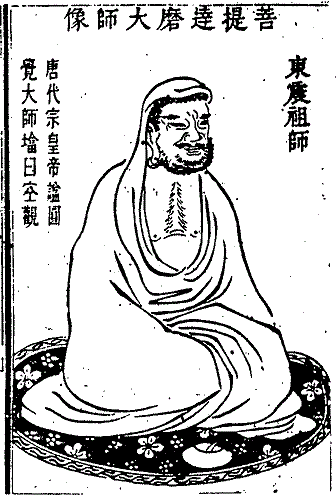
35
The Twenty-eight Indian Patriarch Bodhidharma
(The First Patriarch of China)
Gatha chanted when transmitting the Dharma to the Twenty-ninth Patriarch Hui K'o:
My aim in coming to this country
Was to transmit the Dharma and liberate all beings.
A flower of five petals
Cannot fail to fruit.
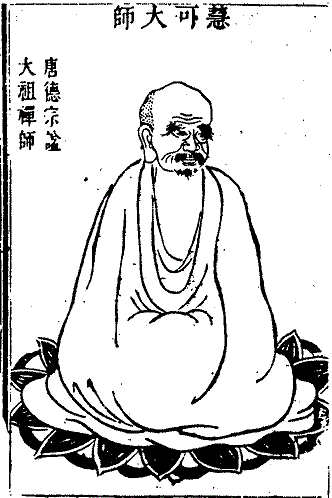
36
The Twenty-ninth Patriarch Hui K'o
(The Second Patriarch of China)
Gatha chanted when transmitting the Dharma to the Thirtieth Patriarch Seng Ts'an:
From the seed-bed (of your mind)
(The Dharma) raises flowers.
Yet there is no seed
Nor are there flowers.
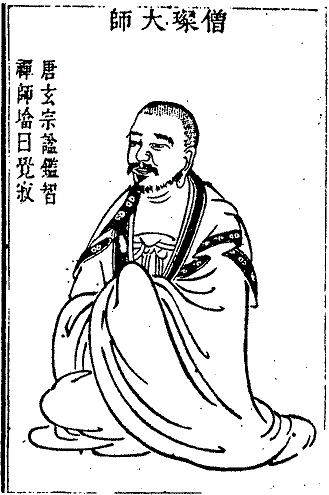
37
The Thirtieth Patriarch Seng Ts'an
(The Third Patriarch of China)
Gatha chanted when transmitting the Dharma to the Thirty-first Patriarch Tao Hsin:
The sowing of flower-seeds requires a causal ground
From which the flowers will grow.
If no one sows there will be
Neither ground nor flowers.
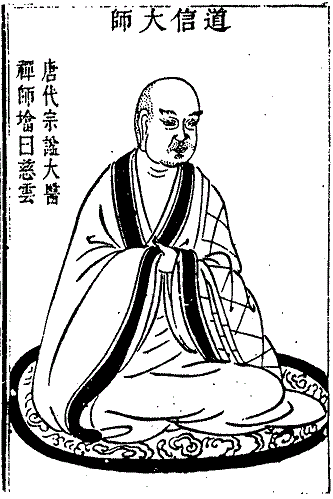
38
The Thirty-first Patriarch Tao Hsin
(The Fourth Patriarch of China)
Gatha chanted when transmitting the Dharma to the Thirty-second Patriarch Hung Jen:
Growth is latent in the seed
Which sprouts when planted in the causal ground.
This Great Cause unites with nature
At the time of growth, yet nothing grows.
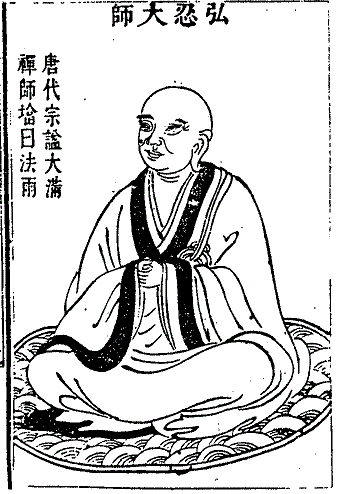
39
The Thirty-second Patriarch Hung Jen
(The Fifth Patriarch of China)
Gatha chanted when transmitting the Dharma to the Thirty-third Patriarch Hui Neng:
The seed sown by a sentient being
In causal ground will soon bear fruit.
Without sentience there is no seed
And no fruit without nature.
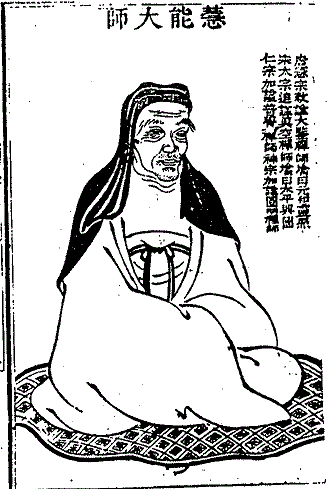
40
The Thirty-third Patriarch Hui Neng
(The Sixth Patriarch of China)
Gatha chanted when transmitting the Dharma to his disciples:
The Mind-ground holds the (flower) seeds
Which sprout when falls the all-pervading rain.
The wisdom-flower of instantaneous awakening
Cannot fail to bear the Bodhi-fruit.
Another set of illustrations with Gathas in Chinese
禪宗西天東土三十三祖道影 ( 附傳法偈 )